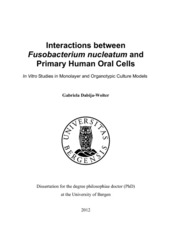| dc.contributor.author | Dabija-Wolter, Gabriela | en_US |
| dc.date.accessioned | 2012-12-10T13:08:11Z | |
| dc.date.available | 2012-12-10T13:08:11Z | |
| dc.date.issued | 2012-06-21 | eng |
| dc.identifier.isbn | 978-82-308-2067-4 (print version) | en_US |
| dc.identifier.uri | https://hdl.handle.net/1956/6223 | |
| dc.description.abstract | F. nucleatum is a Gram-negative bacterium, member of normal flora in the oral cavity, which has a major role in the formation of the subgingival biofilm. The adhesins expressed on the cell wall outer membrane confer F. nucleatum remarkable adhesive properties. F. nucleatum can bind a wide array of oral bacteria, including periodontal pathogens, but also can attach to and enter oral epithelial and endothelial cells and oral tissues, triggering release of molecules that contribute to the periodontal tissue breakdown. The main goal of this study was to investigate the interactions between different oral strains of F. nucleatum and normal human oral cells by use of in vitro cell culture models. The entrance of F. nucleatum into oral fibroblasts of gingival and periodontal ligament origin was the first time investigated in this study. Both type of fibroblasts were invaded by F. nucleatum in a strain-dependent manner, process starting approximately after 1 h of co-culture and continuing for a couple of hours. The periodontal ligament fibroblasts were consistently more loaded with fusobacteria than donor-matched gingival fibroblasts, but the reasons behind this finding remain open to further research. The invasion of F. nucleatum into an organotypic model of gingival mucosa, constructed with primary gingival epithelial cells on top of a collagen matrix containing gingival fibroblasts, was limited to the superficial epithelial layers. Although exposure to F. nucleatum induced strong shredding of the superficial epithelial layers and presence of caspase-3 positive cells in the epithelial compartment, the organotypic tissues kept their proliferative potential after fusobacterial challenge. These findings suggest that fusobacteria were rather efficiently eliminated by the gingival mucosa models, than inducing permanent damage to the organotypic tissues. With the aim of using such models in future comparative and in depth studies on bacterial–host tissue interactions, a range of organotypic models resembling junctional epithelium, sulcular epithelium and gingival epithelium have been successfully developed. It was determined that the type of fibroblasts used in the collagen matrix, together with the time allowed for growth and differentiation have strong impact on the phenotype of epithelium compartment of the organotypics. The periodontal ligament fibroblasts influenced significantly the CK 19 expression and pattern of distribution of proliferating cells in organotypic cultures grown for 5 days, reflecting the closest the phenotype of JE native tissue. The findings described in this study confirm the invasive potential of F. nucleatum documented by other studies in other type of cells and suggest the use of relevant tissue models, developed by use of primary oral cells, for further research in this field. | en_US |
| dc.language.iso | eng | eng |
| dc.publisher | The University of Bergen | eng |
| dc.relation.haspart | Paper I: Gabriela Dabija-Wolter, Mihaela-Roxana Cimpan, Daniela E. Costea, Anne Christine Johannessen, Steinar Sørnes, Evelyn Neppelberg, Mohammed Al-Haroni, Nils Skaug and Vidar Bakken. Fusobacterium nucleatum Enters Normal Human Oral Fibroblasts In Vitro. Full-text not available in BORA. The published version is available at: <a href="http://dx.doi.org/10.1902/jop.2009.090051" target="blank">http://dx.doi.org/10.1902/jop.2009.090051</a> | en_US |
| dc.relation.haspart | Paper II: Gabriela Dabija-Wolter, Dipak Sapkota , Mihaela R. Cimpan , Evelyn Neppelberg, Vidar Bakken, Daniela E. Costea. Limited in-depth invasion of Fusobacterium nucleatum into in vitro reconstructed human gingiva. Full-text not available in BORA. The published version is available at: <a href="http://dx.doi.org/10.1016/j.archoralbio.2011.09.015" target="blank">http://dx.doi.org/10.1016/j.archoralbio.2011.09.015</a> | en_US |
| dc.relation.haspart | Paper III: Gabriela Dabija-Wolter, Vidar Bakken, Mihaela R. Cimpan, Anne Christine Johannessen, Daniela E. Costea. In vitro reconstruction of human junctional and sulcular epithelium. The paper is available at: <a href="http://hdl.handle.net/1956/6222" target="blank">http://hdl.handle.net/1956/6222</a> | en_US |
| dc.title | Interactions between Fusobacterium nucleatum and Primary Human Oral Cells: In Vitro Studies in Monolayer and Organotypic Culture Models | en_US |
| dc.type | Doctoral thesis | |
| dc.rights.holder | Copyright the author. All rights reserved | |
